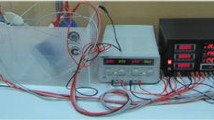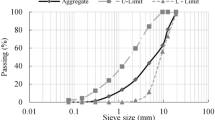Abstract
A monitoring technique based on the chloride selective electrodes for the chloride content in concrete which is accurate, non-destructive, and continuous would be highly desirable. For this reason, the performance, such as Nernst response and resisting polarization, of the electrode was tested both in simulated concrete pore solutions and concrete. Moreover, the surface morphology of electrode after immersion in solutions over 3 months was detected. Results revealed that the electrode potential showed a good Nernst response with chloride concentration and was affected little by sulfate ion. The detection limit for the chloride concentration was 10−3 mol L−1 at pH 13.5 and 10−4 at lower pH values. In addition, the electrode also had a high exchange current density and a high equivalent capacitance. The Ag/AgCl coating showed good long-term stability over 3 months in solutions containing chloride ions. Besides, there was a good agreement between the free chloride content determined by the electrode and by pore solution expression.










Similar content being viewed by others
References
Xu J, Jiang L, Wang W, Tang L, Cui L (2013) Effectiveness of inhibitors in increasing chloride threshold value for steel corrosion. Water Sci Eng 6(3):354–363
Elsener B, Zimmermann L, Böhni H (2003) Non destructive determination of the free chloride content in cement based materials. Mater Corros 54(6):440–446
Montemor MF, Alves JH, Sim Es AM, Fernandes JCS, Louren OZ, Costa AJS, et al (2006) Multiprobe chloride sensor for in situ monitoring of reinforced concrete structures. Cem Concr Compos 28(3):233–236
Xu J, Jiang L, Wang W, Jiang Y (2011) Influence of CaCl2 and NaCl from different sources on chloride threshold value for the corrosion of steel reinforcement in concrete. Constr Build Mater 25(2):663–669
Xu J, Jiang L, Wang J (2009) Influence of detection methods on chloride threshold value for the corrosion of steel reinforcement. Constr Build Mater 23(5):1902–1908
Ann KY, Song H (2006) Chloride threshold level for corrosion of steel in concrete. Corros Sci 49(11):4113–4133
Torres-Luque M, Bastidas-Arteaga E, Schoefs F, Sánchez-Silva M, Osma JF (2014) Non-destructive methods for measuring chloride ingress into concrete: state-of-the-art and future challenges. Constr Build Mater 68:68–81
Oh BH, Jang SY (2007) Effects of material and environmental parameters on chloride penetration profiles in concrete structures. Cem Concr Res 37(1):47–53
Sanchez-Silva M, Klutke G, Rosowsky DV (2011) Life-cycle performance of structures subject to multiple deterioration mechanisms. Struct Saf 33(3):206–217
Alonso MC, Sanchez M (2009) Analysis of the variability of chloride threshold values in the literature. Mater Corros 60(8):631–637
Garzon AJ, Sanchez J, Andrade C, Rebolledo N, Menéndez E, Fullea J (2013) Modification of four point method to measure the concrete electrical resistivity in presence of reinforcing bars. Cem Concr Composs 53:249–257
Taillet E, Lataste JF, Rivard P, Denis A (2014) Non-destructive evaluation of cracks in massive concrete using normal dc resistivity logging. NDT& E INT 63:11–20
Morris W, Moreno EI, Sagues AA (1996) Practical evaluation of resistivity of concrete in test cylinders using a Wenner array probe. Cem Concr Res 26(12):1779–1787
Nguyen TH, Venugopala T, Chen S, Sun T, Grattan KTV, Taylor SE, et al (2014) Fluorescence based fibre optic pH sensor for the pH 10–13 range suitable for corrosion monitoring in concrete structures. Sensors Actuators B: Chem 191:498–507
Maaskant R, Alavie T, Measures RM, Tadros G, Rizkalla SH, Guha-Thakurta A (1997) Fiber-optic Bragg grating sensors for bridge monitoring. Cem Concr Compos 19(1):21–33
Davis MA, Bellemore DG, Kersey AD (1997) Distributed fiber Bragg grating strain sensing in reinforced concrete structural components. Cem Concr Compos 19(1):45–57
Climent-Llorca MA, Viqueira-Pérez E, López-Atalaya MM (1996) Embeddable Ag/AgCl sensors for in-situ monitoring chloride contents in concrete. Cem Concr Res 26(8):1157–1161
Atkins CP, Carter MA, Scantlebury JD (2001) Sources of error in using silver/silver chloride electrodes to monitor chloride activity in concrete. Cem Concr Res 31(8):1207–1211
Duffo GS, Farina SB (2009) Development of an embeddable sensor to monitor the corrosion process of new and existing reinforced concrete structures. Constr Build Mater 23(8):2746–2751
McCarter WJ, Vennesland Ø (2004) Sensor systems for use in reinforced concrete structures. Constr Build Mater 18(6):351–358
Li H, Li D, Song G (2004) Recent applications of fiber optic sensors to health monitoring in civil engineering. Eng Struct 26(11):1647–1657
Umezawa Y (1990) CRC handbook of ion-selective electrodes: selectivity coefficients: CRC press Boca Raton, FL
Jin M, Xu J, Jiang L, Gao G, Chu H, Xiong C, et al (2014) Electrochemical characterization of a solid embeddable Ag/AgCl reference electrode for corrosion monitoring in reinforced concrete. Electrochemistry 82(12):1040–1046
Atkins CP, Scantlebury JD, Nedwell PJ, Blatch SP (1996) Monitoring chloride concentrations in hardened cement pastes using ion selective electrodes. Cem Concr Res 26(2):319–324
Angst U, Elsener B, Larsen CK, Vennesland Ø (2010) Potentiometric determination of the chloride ion activity in cement based materials. J Appl Electrochem 40(3):561–573
Janata J (1989) Principles of chemical sensors. Plenum Press, New York
Koryta J (1972) Theory and applications of ion-selective electrodes. Anal Chem Acta 61(3):329–411
Sun C, Chen J, Zhu J, Zhang M, Ye J (2013) A new diffusion model of sulfate ions in concrete. Constr Build Mater 39:39–45
Tumidajski PJ, Chan GW, Philipose KE (1995) An effective diffusivity for sulfate transport into concrete. Cem Concr Res 25(6):1159–1163
Ives DJ, Janz GJ, King CV (1961) Reference electrodes: theory and practice. J Electrochem Soc 108(11):246–247
Dobos D (1975) Electrochemical data: a handbook for electrochemists in industry and universities. Elsevier Scientific Publishing Company Amsterdam
Brossia CS, Kelly RG (1996) A reference electrode for use in methanol solutions. Electrochim Acta 41(16):2579–2585
Teijelo ML, Vilche JR, Arvia AJ (1984) The electroformation and electroreduction of anodic films formed on silver in 0.1 < i > M sodium hydroxide in the potential range of the Ag/Ag < sub > 2 O couple. J Electroanal Chem Interfacial Electrochem 162(1):207–224
Duffó GS, Farina SB, Giordano CM (2009) Characterization of solid embeddable reference electrodes for corrosion monitoring in reinforced concrete structures. Electrochim Acta 54(3):1010–1020
Hsu CH, Mansfeld F (2001) Technical note: concerning the conversion of the constant phase element parameter Y0 into a capacitance. Corrosion 57(9):747–748
Muralidharan S, Saraswathy V, Thangavel K, Palaniswamy N (2008) Electrochemical studies on the performance characteristics of alkaline solid embeddable sensor for concrete environments. Sensors Actuators B: Chem 130(2):864–870
Svegl F, Kalcher K, Grosse-Eschedor YJ, Balonis M, Bobrowski A (2006) Detection of chlorides in pore water of cement based materials by potentiometric sensors. Rare Metal Mater Eng 35:232–237
Angst U, Vennesland Ø (2009) Detecting critical chloride content in concrete using embedded ion selective electrodes—effect of liquid junction and membrane potentials. Mater Corros 60(8):638–643
Angst U, Vennesland Ø, Myrdal R (2009) Diffusion potentials as source of error in electrochemical measurements in concrete. Mater Struct 42(3):365–375
Angst UM, Polder R (2014) Spatial variability of chloride in concrete within homogeneously exposed areas. Cem Concr Res 56:40–51
Acknowledgments
The authors gratefully acknowledge the support provided by the National Key Technology Research and Development Program of the Ministry of Science and Technology of China (2015BAB07B04), the Natural Science Foundation of China (nos. 51278167, 51278168, 51478164, and 51479051) and the Natural Science Foundation of Jiangsu province under Project (no. BK20131374).
Author information
Authors and Affiliations
Corresponding author
Rights and permissions
About this article
Cite this article
Jin, M., Xu, J., Jiang, L. et al. Investigation on the performance characteristics of chloride selective electrode in concrete. Ionics 21, 2981–2992 (2015). https://doi.org/10.1007/s11581-015-1485-0
Received:
Revised:
Accepted:
Published:
Issue Date:
DOI: https://doi.org/10.1007/s11581-015-1485-0




